| |
The Tōkaidō
As the main thoroughfare linking Kyoto, the imperial capital, and Edo (now Tokyo), the capital of Tokugawa shoguns, the Tōkaidō figured prominently in the history, literature, and art of Japan. Westerners could experience the Tōkaidō directly since it passed through the treaty-port limits of Yokohama. Beato’s photographs and the captions that accompany them explore the famous highway from the vantage point of both history and culture.
|
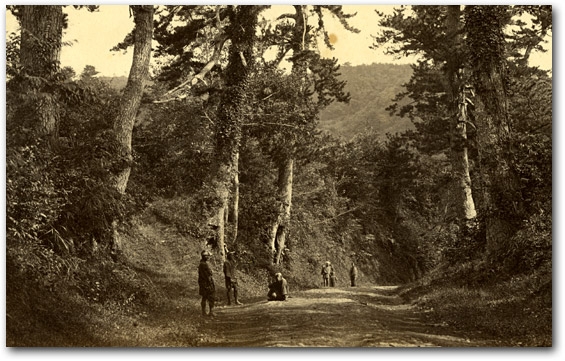 |
“View on the Tōkaidō” (detail)
[bjh02]
|
View on the Tōkaidō, for example (above), depicts a scenic stretch of the tree-lined highway; the caption brings the view to life historically by noting the Tōkaidō’s preeminence among the many highways constructed to serve the needs of Edo. The caption mentions that powerful provincial lords (daimyō) and their retinues traveled the highway on their annual sojourns to and from the capital. It also draws Westerners into the history of the Tōkaidō by quoting the following passage from Engelbert Kaempfer’s three-volume account of his life in Japan:
“In the early years of the 17th century, one of the first foreign travellers thus remarks upon the Tokaido:—“On what ever side one turns his eye, he perceives a concourse of people turning to and fro, as in the most populous cities of Europe. The roads are lined on both sides with superb pine-trees, which keep off the sun. The distances are marked with little eminences planted with two trees.”
|
As the physician attending the Dutch community at Nagasaki in the late-seventeenth century, Kaempfer traveled with leaders of the Dutch trading mission on their annual journeys to Edo to pay their respects to the shogun. Invoking Kaempfer in this caption was an effective, perhaps even empathetic, means of drawing 19th-century Westerners into the storied history of the highway.
But the Tōkaidō was attractive to Beato and the clientele he served for more than just its historic associations. It was remarkably beautiful! The caption for the first photograph in the album, The Tokaido, Between Yokohama and Fujisawa (below), states explicitly “portions of the road are strikingly picturesque, and some beautiful views are obtained.”
|
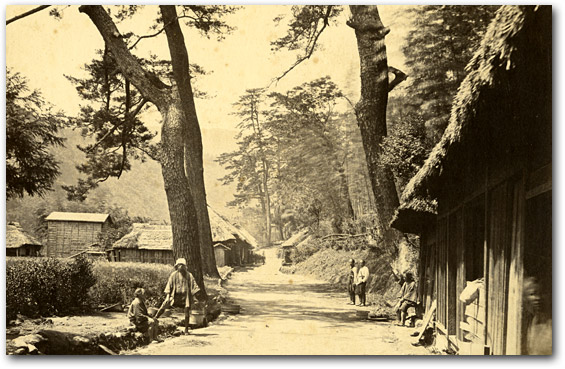 |
“The Tokaido, between Yokohama and Fujisawa” (detail)
[bjh01]
|
The term picturesque (meaning picture-like) had, since the mid-eighteenth century, come to define an aesthetic associated with pastoral landscapes. Its use evoked nostalgia for a rural lifestyle that was rapidly disappearing with the industrial revolution. The term was also associated with travel, particularly to the Lake District in England, where people of means escaped the urban environment of cities. The caption for another photograph of the Tōkaidō (image three, below) makes this connection explicit:
“There is no traffic on the roads of a nature likely to cut them into ruts, or necessitate their frequent repair; there are no carriages, public or private, of any sort in Japan—no rattling teams of horses with heavy “Busses” behind them—no coaches with emulative whips trotting along at an exhilarating pace—such a profession as a Post boy is unknown! The echoes of the lovely dells, of which there are many on the Tokaido, are never roused by the cheering sound of the Guard’s horn, the remembrance of which, still suggests to ancient lovers of the days of posting in England, the wish, that stage coaches in their glory had not been superseded by the rapid whirl of the railway engine—foot passengers and horses, shod alike with shoes made of straw, or coolies carrying goods or norimons or native chairs, are the only traffic taking wear or tear of any road.”
|
|
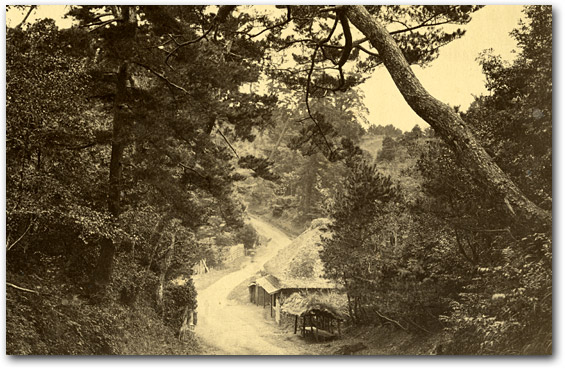 |
“The Tokaido” (detail)
[bjh03]
|
It seems that Beato’s photographs of the Tōkaidō used the picturesque character of rural Japan to invoke longing for an environment that was rapidly disappearing in the home countries of his Western customers.
Kamakura
Kamakura lay within the treaty limits of Yokohama and became an important destination for one-day excursions from Yokohama, primarily because of the many Buddhist temples and Shinto shrines located there.
|
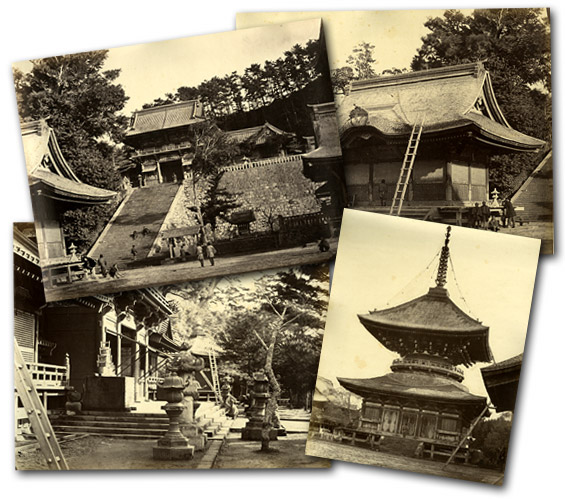 |
Kamakura was a popular day trip for Westerners, who were fascinated
with its temples, shrines, and Buddhist icons.
[bjh 18 - 21]
|
Among these, Beato’s image of the steps leading up to the great Hachiman Shrine, dedicated to the Shinto god of war, became one of his most reproduced photographs.
|
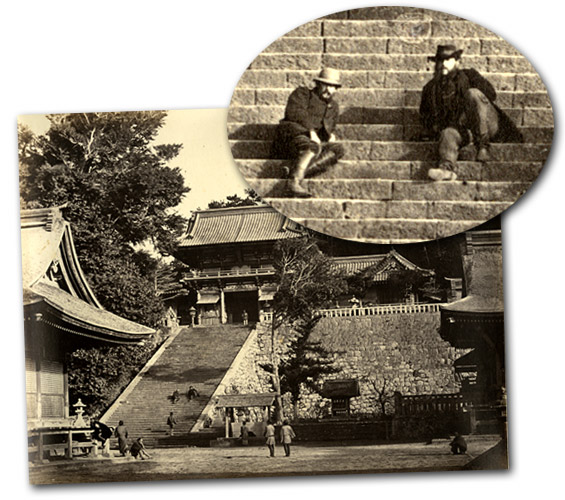 |
  An often reproduced Beato photograph of the famous Hachiman Shrine in Kamakura. The two men relaxing on the steps appear to be Felice Beato himself and his colleague Wirgman. An often reproduced Beato photograph of the famous Hachiman Shrine in Kamakura. The two men relaxing on the steps appear to be Felice Beato himself and his colleague Wirgman.
[bjh18] |
The tahōtō, a unique type of pagoda in the temple complex, also acquired iconic status and was replicated by many later commercial photographers.
|
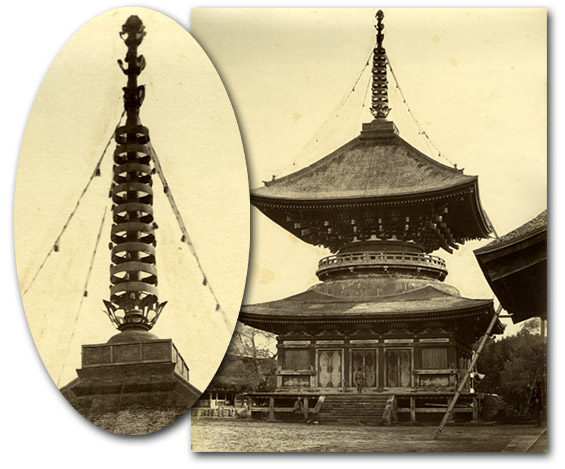 |
  This single-storied pagoda, known as a tahōtō or “pagoda of many treasures,” became one of the most photographed religious structures in Kamakura. This single-storied pagoda, known as a tahōtō or “pagoda of many treasures,” became one of the most photographed religious structures in Kamakura.
[bjh20] |
By far the most important attraction at Kamakura was the large bronze Daibutsu, or “Great Buddha.” This sculpture was the main icon of a temple that had been destroyed by a typhoon. Once exposed, its commanding stature was only enhanced by its open-air setting. The caption for Beato’s image obliges Western fascination with the sheer monumentality of the Daibutsu by citing its measurements (“…about 50 feet…high. …The circumference of the body is 98 feet…”). Travel accounts written by those who visited the site frequently quote these statistics.
|
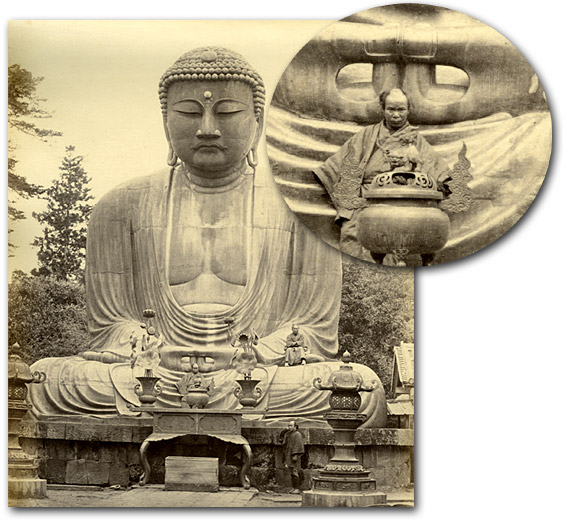 |
  “The Bronze Statue of Dai-Bouts” “The Bronze Statue of Dai-Bouts”
The detail inset of a man seated before the thumbs and forefingers of the meditating Buddha demonstrates the impressive size of the statue. This famous Kamakura buddha was originally housed in a temple building that was destroyed in medieval times.
[bjh17] |
Perhaps to emphasize the attraction Kamakura had for foreigners, Beato included Westerners in many of his photographs. The two gentlemen reclining on the steps of the Hachiman Temple are none other than Wirgman and Beato (see image 18, above). In another photograph, a foreigner leans against the base of one of the smaller buildings at the shrine.
|
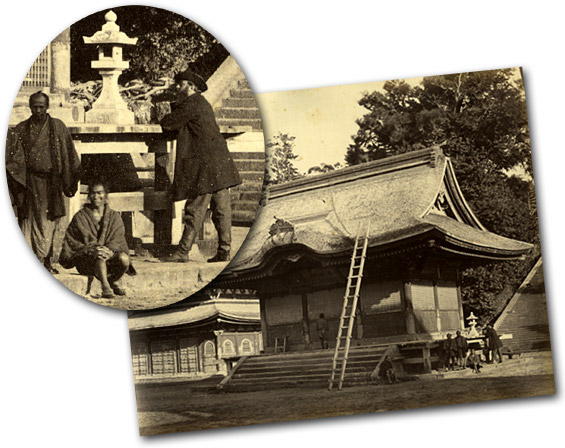 |
  “Kamakura” “Kamakura”
This photograph was taken at the base of the long staircase leading to the Hachiman Shrine pictured in image 18 (above). The Westerner admiring the structure is thought to be Beato.
[bjh19] |
The captions for Beato’s images of Kamakura focus on the obvious attractions of the site. Local Buddhist customs and practices are discussed in caption 19. The historical significance of Kamakura, particularly its role as the military capital of Japan from the late-twelfth through mid-fourteenth centuries, is spread between captions 18 and 21. Curiously, the historical order is reversed in the Hood Museum album. Caption 18 discusses the fall of Kamakura to invading forces in 1333 while caption 20 covers the history of the town from the eighth through twelfth centuries. It seems that the visual order of the photographs took precedence over the chronological sequence suggested by the captions. Caption 21 complicates matters further—it is exactly the same as caption 20. This suggests that Beato had a limited supply of captions for each locale he photographed. Among the sixteen images of Edo in the Hood Museum album (discussed below), six depicting the Tokugawa mausoleums at Shiba are all paired with the same caption. The complete transcribed text of all captions is available in the Resources section.
The historical associations of the sites Beato photographed constitute one of the dominant themes running through the captions in Beato’s albums. But these histories were not limited to only ancient matters. Recent history, particularly if it involved Westerners, provided another means by which Beato’s photographs were given meanings that his clientele would find attractive. For the photograph titled View Near Kamakura Where Major Baldwin and Lieut. Bird Were Murdered (image 24, below) the caption describes the murder and its consequences as follows:
“About half way down the center of a long avenue, called the “path of the Gods” which runs in a straight line from the sea to the Temple of Hachiman;—is a spot which has obtained a melancholy celebrity to Foreigners, from its having been the scene of the murder of two English officers.
On the 21st November 1864, Major George Walter Baldwin and Lieutenant Robert Nichols Bird—both of the 2nd Battalion H. B. M. XX Regiment, left Yokohama on horseback for a visit to Kamakura and its neighbourhood. After going as far as Inosima [sic], where they breakfasted with Mr. Beato and some other excursionists, they left about noon with the intention of visiting Daiboots [sic]; while crossing the little stone bridge shewn in the picture opposite, they were attacked from behind, and cut down before they had an opportunity of defending themselves, or drawing the revolvers with which they were both armed. Information being sent the same night, by the district authorities, to the Governor of Kanagawa and by him communicated to the Foreign Consuls; several parties of foreigners, and a detachment of mounted Artillery, at once proceeded to the spot; and found the bodies of the unfortunate officers under a small shed covered with mats—the only information that could be elicited from the natives was, that the younger officer had lived for some hours after being cut down, and the elder, Major Baldwin, had been killed at once.
The remains of the two officers were brought in and buried with military honours in the Cemetery at Yokohama.
Owing to the vigorous measures adopted by Sir Rutherford Alcock, two men said to be concerned in this murder, were executed in the presence of numerous Foreigners on the 16th December—the real perpetrator of the crime however, a leading Lonin [sic], a man of considerable standing, education and acquaintance, also of great strength and powerful build, being afterwards captured, was publicly beheaded at Tobe, in presence of the English Troops on the morning of 28th December 1864.
This mans name was Shimadzo Seyee. He had been a Samourai [sic] of some influence, but voluntarily became a Lonin [sic], and confessed that it was his great desire to kill a foreigner—he thought that the two officers, whom he and another had attacked at Kamakura were Consuls, and described so minutely the manner of attack, that it left no doubt on anyone’s mind that he was the principle murderer. His coolness and courage at the time of execution were remarkable—worthy of a better cause.
His head was exposed to view for three days near the principle bridge leading into Yokohama.”
|
|
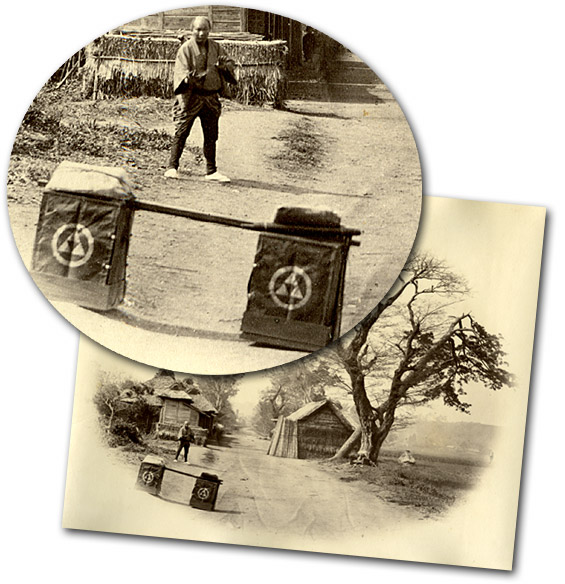 |
  This serene scene belies the site’s significance as the place where two English officers were murdered by samurai fighting the influx of foreigners into Japan. The story is recounted in detail in the accompanying caption. The figure standing peacefully by the roadside appears to be a traveling peddler who has laid down the wares he carried on a pole over his shoulder. This serene scene belies the site’s significance as the place where two English officers were murdered by samurai fighting the influx of foreigners into Japan. The story is recounted in detail in the accompanying caption. The figure standing peacefully by the roadside appears to be a traveling peddler who has laid down the wares he carried on a pole over his shoulder.
[bjh24]
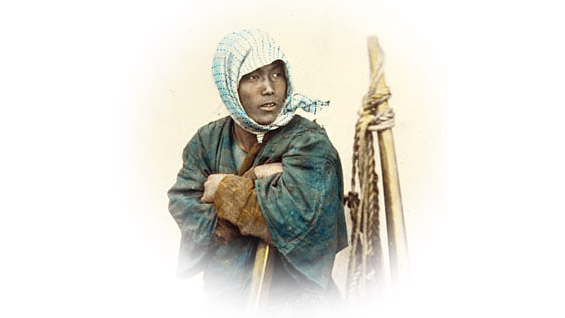
 
Beato includes this photo of a porter in his companion album focusing on Japanese in various walks of life. The accompanying caption states, “How he comes into the world is a mystery, how he lives is a wonder, and what becomes of him when he dies nobody seems to care. His whole property and stock in trade consist of a stout bamboo or piece of wood about five feet long, and some straw rope.”
[bjs27 detail]
Smith College Museum of Art
|
The incident described here and memorialized in Beato’s photograph was one of the more horrific of several attacks on the foreign residents of Yokohama by disgruntled samurai intent on ridding Japan of the Western barbarians. The perpetrators of the Baldwin and Bird murders were eventually captured and members of the foreign community were invited to witness their executions. Wirgman supplied a lengthy and gruesome account of the beheading of the criminals. Beato photographed the severed head of Shimizu Seiji (written Shimadzo Seyee in the caption), the ringleader of the assault, which, as noted in the caption, was publicly displayed according to Japanese legal custom. Western fascination with Japanese jurisprudence—particularly punishment for criminal acts—increased substantially as a result. Beato capitalized on this interest by visiting the public execution grounds close to Yokohama and photographing the severed heads and crucified remains of criminals. He also restaged the Shimizu execution in his studio. Both images were popular with his customers and appear often in the albums they purchased.
|
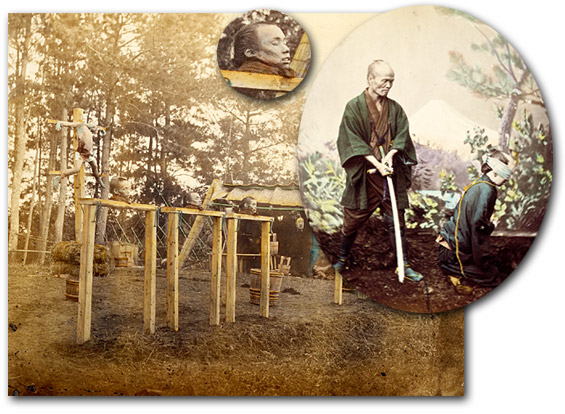 |
  Two photographs from the companion volume of Beato’s “Views of Japan” album deal with execution as a punishment in Meiji Japan. The left image captures a real execution site with three severed heads and a crucifixion. The right image is a studio reenactment of an execution; the caption makes reference to the execution of Shimizu, a samurai held responsible for the murder of the two English officers mentioned above. Two photographs from the companion volume of Beato’s “Views of Japan” album deal with execution as a punishment in Meiji Japan. The left image captures a real execution site with three severed heads and a crucifixion. The right image is a studio reenactment of an execution; the caption makes reference to the execution of Shimizu, a samurai held responsible for the murder of the two English officers mentioned above.
[bjs49 and 50]
Smith College Museum of Art
|
Although it may be difficult to understand the attraction of photographs showing the site of violent murders and the remains of executed criminals, such images were central to several late-19th-century Western conceptualizations of Japan. Whether justified or not, most foreigners were deeply respectful of Japanese traditions, particularly those associated with the samurai. Descriptions of executions written by Westerners revel in their raw violence; at the same time they reveal an often-understated admiration for the stoicism of both executioner and victim. As the caption states: “His [Shimizu’s] coolness and courage at the time of execution were remarkable—worthy of a better cause.”
|
|
|

